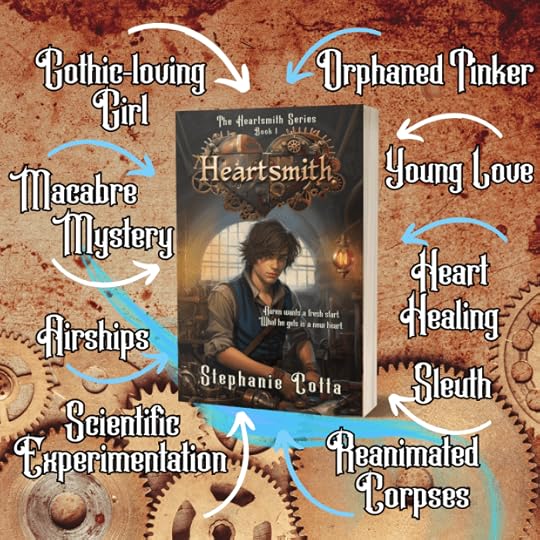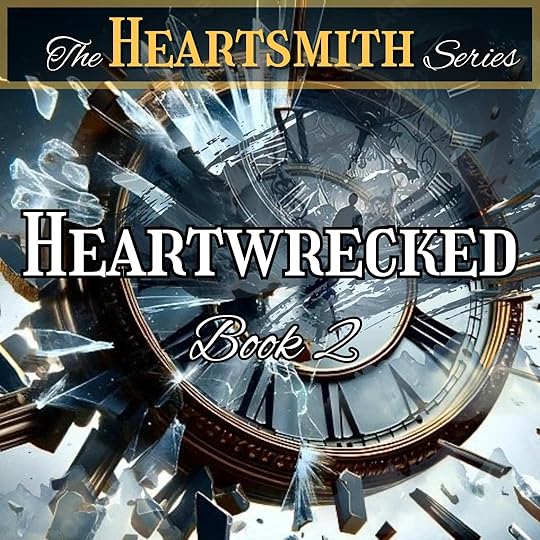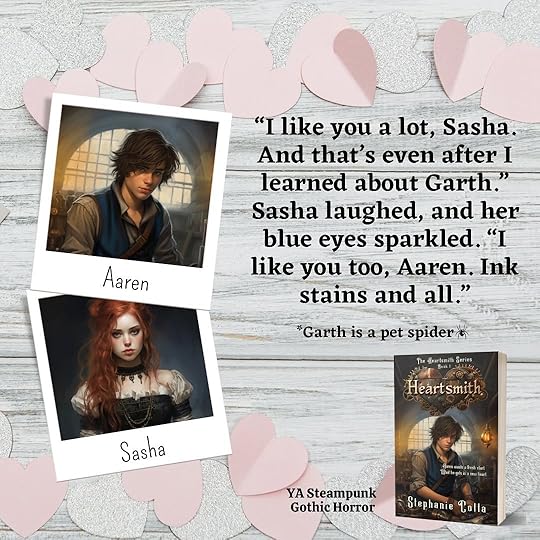Heartsmith–A Dynamic Steampunk Fantasy, an Author Interview, and a Great Giveaway
I don’t think I’ve every posted two reviews of the same book on my blog, but I’m making an exception this time. The first review of Heartsmith by Stephanie Cotta was by Kate Lundeen. Since then, I read it and wanted to share with all of you why I loved it.
 REVIEW
REVIEWI confess. I wasn’t a steampunk fantasy fan. But now, that’s in the past. After reading Heartsmith, Book 1 In the Heartsmith series, I have a new perspective on this genre. A YA book that teens will love, Heartsmithconvinced me that a futuristic dystopian—yet Victorian world is not only possible, but intriguing and able to keep my interest for 250+ pages.
Part adventure, part romance, part gothic horror, Cotta paints a picture of a world in which the villain snatches dead children and recreates them as his minions. The evil doctor’s goal? To find a way to achieve immorality—power over life and death.
The book starts innocently enough. Sixteen-year-old Aaren Lockett, travels to the metropolis of Rexanburg to start a new life. A tinker by trade with dreams of being an inventor, he’s excited to be in a city known for being the hub of industry and innovation. But by the second chapter he’s stumbled into a firefight, is shot at, left for dead, and is resurrected by a woman with lavender skin—his new Heartspirit whose name is Aida. All that in 15 pages.
Aaren’s new world has sky ships that skirmish in the skies above and yet is paved with cobblestone streets where carriages and motor cars whiz by. He meets an attractive young newspaper woman and the two of them band together to uncover the mysteries of where her dead brother’s body disappeared to. This leads them to a seedy neighborhood, and eventually to the skies themselves—and Aaren’s villainous antagonist.
Although the book is written for a general audience, there is Christian symbolism throughout. When Aaren is brought back to after being mortally wounded, Aida tells him that she is a Contract and her people can heal any affliction. “We absorb that affliction, nursing the pain inside our own bodies so our masters may be free of any ill effects. Though mortal wounds come at the cost of our own lives.”
That theme continues as Aida insists Aaren must be healed of his deep wounds from his troubled childhood. After healing sessions with her, he sees a blue light in his veins. Aida says, “This is the FLOW of your Heartspirit. Now that you have unburdened your heart, its Spirit Energy can be used to enter another. This is how we repair afflictions, even Heartspirits.” From then on, Aaren possesses the same power to heal physical pain that Aida has—often at a great cost to himself.
The climax—when Aaren faces the mad doctor who wants to kill him so he can gain Aaren’s power—is both frightening and beautiful. But most of all, it’s an amazing cliffhanger so that every reader will be anxious for Book 2- Heartwrecked.
 AUTHOR INTERVIEW
AUTHOR INTERVIEWCAROL: Do you start with the characters, world, or plot first?
STEPHANIE: For every book I’ve written, the main character always came first, then I shaped the world around them. With The Conjurer’s Curse, the story came about because I asked the question: What if a teenage boy had an invisible life-draining curse that killed everyone around him? Rowan was created right away from that thought. I didn’t know where his curse came from, who cursed him, or any of those details—I would discover them as Rowan does.
It was the same with Aaren Lockett from Heartsmith. I wanted to write a Steampunk story set in a Dickens-style world. It wasn’t until I considered it would be fun to center the story around a 16-yr-old orphan (like Oliver Twist) who wanted to have a fresh start as a tinker in an industrial metropolis that the plot details poured in from there.
CAROL: I am fascinated by your world building. How do you do it? Any tricks of the trade for other fantasy writers?
STEPHANIE: Start by asking yourself this basic question: what makes your world unique? From that question you can break it down into multiple segments. For Heartsmith, I knew I wanted a blend of German and English influences revolving around the Industrial Revolution time period. From there, I added in the steampunk elements: airships, timepieces, gears, steam trains, automatons etc. The Frankenstein gothic vibes came a little later. I set the story aside for a season, and then after brainstorming with family, we came up with the idea of a mad scientist experimenting with reanimating the dead. That helped me get “unstuck” with my plot, and took the story into a new direction I never had planned.
**** Brainstorm worldbuilding and plot ideas with friends, family, and critique partners.
CAROL: What has influenced you in creating your fantasy worlds?
STEPHANIE: I was drawn to fantasy stories at an early age when I started reading Star Wars and The Chronicles of Narnia. And after the Lord of the Rings movies came out, I became a true fantasy nerd! Authors who influenced my writing and inspired me to create my own fantasy worlds are J.R.R. Tolkien, C.S. Lewis, Brandon Sanderson, and Timothy Zahn.
CAROL: You are also an artist. How much is art a part of your writing or does one inspire the other?
STEPHANIE: I’ve been an artist longer than I’ve been a writer, so yes, art is very much a part of my writing. I love painting scenes with my words. I often remark that if I didn’t paint a picture for the reader to visualize and be immersed in the scene, then I didn’t do my job correctly. When I start writing a scene, it’s often from a small blip of dialogue. I call this the “skeleton” stage because when I learned to first draw the human figure, I had to start with the basic skeletal structure. Then I add on the muscle. In a scene, this means weaving in character actions, setting cues, the five senses, etc. Next comes the flesh, and that’s the polishing round: smoothing out the prose, and removing any excess that may slow the pacing.
So, this is how my artist/writing brain works! In Heartsmith, I had a wonderful time visualizing my characters through paintings, which are included in the interior of the book. Here’s Jazzy, a fan favorite from Heartsmith.

CAROL: I assume you consciously were inserting a Christian theme, although it doesn’t dominate the book. Can you talk about that?
STEPHANIE: When I first started brainstorming about this story, the title Heartsmith came right at the inception. So I had to ask myself, “What does a Heartsmith do?” Naturally, that would be healing hearts. But I wanted to go deeper with the concept. In Galatians 6:2, it says, “Bear one another’s burdens…” This helped me create the cost associated with Aaren healing others: he bears the pain burdens for others—kinda like Jesus does.
So, if my main character, Aaren Lockett, was going to be a Heartsmith, then his own heart needed mending—and not just physically, but emotionally and spiritually. In his “heart sessions” with Aida—his new Heartspirit, much like the Holy Spirit—represents an inner guide for Aaren, as he visits trauma from his past. It’s only once Aaren has received his own healing that he can then help others. He now has the strength and compassion to bear burdens for others.
CAROL: How do you write several series at the same time?
I’ll say that it isn’t easy. It can be tricky jumping from a steampunk gothic world to a medieval fantasy. But there were days that I needed a break from the high stakes drama in The Iron Kingdom Series (YA Fantasy), so I would switch to Heartsmith and find myself immersed again. One thing that helps me “shift gears” is the right music playlist. I have an Epic Fantasy Playlist, and one specifically for the Heartsmith series. Listening to them while driving, working out, hiking, helps center my mind back to the characters and world for each story.
CAROL: Do you dream in fantasy?
STEPHANIE! My dreams have been the inspiration behind a few of my fantasy stories. My sleeping hours often become my brainstorming sessions too. I’ve visualized countless scenes this way. I’ve always had a very active imagination, and there’ve been plenty of times that I’ve woken up to a character talking in my head, so I had to quickly write down what they said in my notes app so I didn’t lose it.
For me, when I’m at “rest” in bed, my mind relaxes and becomes more creative. I’ve fixed quite a number of plot holes while daydreaming before bed.
CAROL: Do you know you’re going to be writing a series when you start out, or does it evolve? Do you plot out the series ahead of time or work on each book as you get to it?
I don’t usually know if I’m writing a series or not until I get near the end of writing the first draft. With The Conjurer’s Curse, I had planned for it to be a standalone—an offshoot from my Adult Epic Fantasy Series. But my publisher Jen Lowry of Monarch Press saw series potential with it. So I adjusted the ending slightly, and it is now a series, with the 3rd book, The Ghost’s Gambit, releasing fall 2025.
With Heartsmith, I didn’t plot it out to be a series either, because again, I’m not a plotter. I just tagged along with Aaren and Sasha and when I realized things couldn’t be wrapped up with one book, I then went into the final act with that in mind. And that’s why I left a killer cliffhanger at the end of this book!
GIVEAWAYI am giving away my gently read copy of Heartsmith along with the swag which Stephanie sent me when I preordered the book. The giveaway ends on March 5. If you are a teenager reading this blog, or plan to give this book to a teen, I’ll put your name in twice. U.S. addresses only.

The post Heartsmith–A Dynamic Steampunk Fantasy, an Author Interview, and a Great Giveaway first appeared on Carol Baldwin - Author, Teacher, Speaker .



